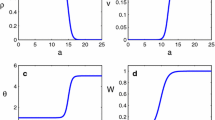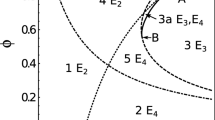Abstract
There is increasing experimental evidence that exposure to low doses of infection may ‘prime’ the immune response of invertebrate hosts, giving them greater protection against future infection. This form of immune memory is not compatible with the ‘acquired immunity’ modelled by the classic Susceptible-Infected-Recovered (SIR) epidemiological model, but instead requires the development of an alternative Susceptible-Primed-Infected (SPI) framework. Some initial theoretical work has explored the epidemiological and evolutionary dynamics of the SPI model, but these have assumed hosts exist in a constant environment. In reality, natural invertebrate-disease systems will be subject to significant environmental variation. Here, I use bifurcation analysis using numerical continuation software, complemented with numerical simulations, to investigate the effects of seasonal forcing on the already complex epidemiological dynamics of the SPI model. I show that multi-year cycles, quasi-periodicity, chaos, and multiple stability may all result, and highlight the importance not just of the forcing amplitude, but also the ecological and epidemiological background, for complex dynamics to emerge.







Similar content being viewed by others
References
Altizer, S., Dobson, A., Hosseini, P., Hudson, P. J., Pascual, M., & Rohani, P. (2006). Seasonality and the dynamics of infectious disease. Ecol. Lett., 9, 467.
Anderson, R. M., & May, R. M. (1979). Population biology of infectious diseases: part I. Nature, 280, 361–367.
Anderson, R. M., & May, R. M. (1980). Infectious diseases and population cycles of frest insects. Science, 210, 658–661.
Aron, J. L., & Schartz, I. B. (1984). Seasonality and period-doubling bifurcations in an epidemic model. J. Theor. Biol., 110, 665–679.
Berryman, A. A. (1996). What causes population cycles of forest Lepidoptera. Trends Ecol. Evol., 11, 28–32.
Best, A., Tidbury, H., White, A., & Boots, M. (2013). The evolutionary dynamics of within-generation immune priming in invertebrate hosts. J. R. Soc. Interface, 10, 20120887.
Bolzoni, L., Dobson, A. P., Gatto, M., & De Leo, G. A. (2008). Allometric scaling and seasonality in the epidemics of wildlife diseases. Am. Nat., 172, 818–828.
Bonsall, M. B. (2004). The impact of diseases and pathogens on insect population dynamics. Physiol. Entomol., 29(3), 223–236.
Casagrandi, R., Bolzoni, L., Levin, S. A., & Andreasen, V. (2006). The SIRC model and influenza A. Math. Biosci., 200, 152–169.
Childs, D. Z., & Boots, M. (2010). The interaction of seasonal forcing and immunity and the resonance dynamics of malaria. J. R. Soc. Interface, 7, 309–319.
Doedel, E. J. (2007). http://indy.cs.concordia.ca/auto.
Doedel, E. J., & Oldeman, B. E. (2009). AUTO-07P: Continuation and bifurcation software for ordinary differential equations. Technical report, Concordia University, Montreal, Canada.
Earn, D., Rohani, P., Bolker, B., & Grenfell, B. T. (2000). A simple model for complex dynamical transitions in epidemics. Science, 287, 667–670.
Glendinning, P., & Perry, L. P. (1997). Melnikov analysis of chaos in a simple epidemiological model. J. Math. Biol., 35, 359–373.
Greenman, J. V., Kamo, M., & Boots, M. (2004). External forcing of ecological and epidemiological systems: a resonance approach. Physica D, 190, 136–151.
Kermack, W. O., & McKendrick, A. G. (1927). Contributions to the mathematical theory of epidemics—1. Proc. R. Soc. Lond. B, Biol. Sci., 115A, 700–721.
Kuznetsov, Y., Muratori, S., & Rinaldi, S. (1992). Bifurcations and chaos in a periodic predator-prey model. Int. J. Bifurc. Chaos, 2, 117–128.
Kuznetsov, Y., & Piccardi, C. (1994). Bifurcation analysis of periodic SEIR and SIR epidemic models. J. Math. Biol., 32, 109–121.
Kuznetsov, Y. (1995). Elements of applied bifurcation theory. Berlin: Springer.
Little, T., & Kraaijeveld, A. R. (2004). Evological and evolutionary implications of immunological priming in invertebrates. Trends Ecol. Evol., 19, 58–60.
Little, T., O’Connor, B., Colgrave, N., Watt, K., & Read, A. F. (2003). Maternal transfer of strain-specific immunity in an invertebrate. Curr. Biol., 13, 489–492.
Moret, Y., & Siva-Jothy, M. T. (2003). Adaptive innate immunity? Responsive-mode prophylaxis in the mealworm beatle Tenebrio molitor. Proc. R. Soc. Lond. B, Biol. Sci., 270, 2475–2480.
Myers, J. H. (1988). Can a general hypothesis explain population cycles in forest Lepidoptera? In M. Begon, A. H. Fitter, E. D. Ford & A. Macfayden (Eds.), Advances in ecological research (Vol. 18). San Diego: Academic Press.
Rinaldi, S., Muratori, S., & Kuznetsov, Y. (1993). Multiple attractors, catastrophes and chaos in seasonally perturbed predator-prey communities. Bull. Math. Biol., 55, 15–35.
Roth, O., Sadd, B. M., Schmid-Hempel, P., & Kurtz, J. (2009). Strain-specific priming of resistance in the red flour beetle, Tribolium castaneum. Proc. R. Soc. Lond. B, Biol. Sci., 276, 145–151.
Sadd, B. M., & Schmid-Hempel, P. (2006). Insect immunity shows specificity in protection upon secondary pathogen exposure. Curr. Biol., 16, 1206–1210.
Schmid-Hempel, P. (2005). Evolutionary ecology of insect immune defenses. Annu. Rev. Entomol., 50, 529–551.
Schwartz, I. B. (1985). Multiple stable recurrent outbreaks and predictability in seasonally forced nonlinear epidemic models. J. Math. Biol., 21, 347–361.
Smith, H. L. (1983). Subharmonic bifurcation in an S-I-R epidemic model. J. Math. Biol., 17, 163–177.
Tate, A. T., & Rudolf, V. H. W. (2011). Impact of life stage specific immune priming on invertebrate disease dynamics. Oikos.
Taylor, R. A., Sherratt, J. A., & White, A. (2012, in press). Seasonal forcing and multi-year cycles in interacting populations: lessons from a predator-prey model. J. Math. Biol. doi:10.1007/s00285-012-0612-z.
Tidbury, H., Pedersen, A. B., & Boots, M. (2011). Within and transgenerational immune priming in an insect to a dna virus. Proc. R. Soc. Lond. B, Biol. Sci., 278, 871–876.
Tidbury, H., Best, A., & Boots, M. (2012). The epidemiological consequences of immune priming. Proc. R. Soc. Lond. B, Biol. Sci., 279, 4505–4512.
White, A., Bowers, R. G., & Begon, M. (1996). Host-pathogen cycles in self-regulated forest insect systems: resolving conflicting predictions. Am. Nat., 148, 220–225.
Acknowledgements
I wish to thank Rachel Taylor, Andy White, Hannah Tidbury, and Mike Boots for useful comments and discussions in the development of this manuscript, as well as two anonymous reviewers for their helpful suggestions and insights on a previous version of this manuscript.
Author information
Authors and Affiliations
Corresponding author
Rights and permissions
About this article
Cite this article
Best, A. The Effects of Seasonal Forcing on Invertebrate-Disease Interactions with Immune Priming. Bull Math Biol 75, 2241–2256 (2013). https://doi.org/10.1007/s11538-013-9889-3
Received:
Accepted:
Published:
Issue Date:
DOI: https://doi.org/10.1007/s11538-013-9889-3




